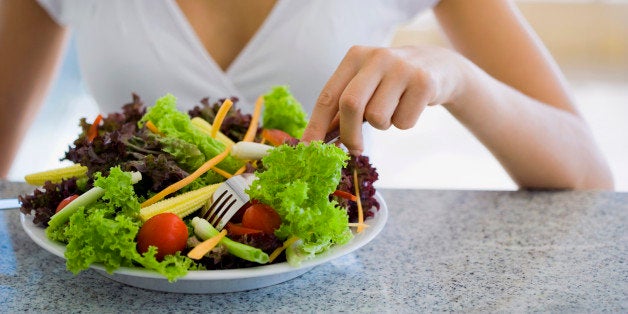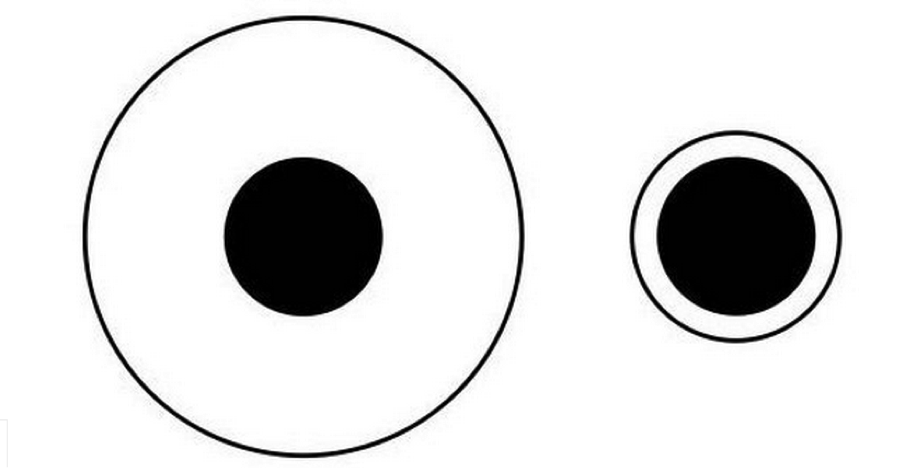
Most of us have a real desire to eat healthier, whatever our current eating habits might be like. We keep reading articles, joining programs, following trendy diets. There is a constant struggle to give it one more try, begin anew, reset the health/diet/fitness tableau and finally take back control. But then we give up -- the plans and diets are too drastic, too limiting, too hard to stick to. Soon we've given up on giving up the carbs, or sugar, or dairy, or gluten...
Here are five super simple tricks to eating healthier. You can begin right now, and if you don't keep to the tenets one day, just start again the next. There's nothing groundbreaking here. They are easy and painless to follow -- so no excuses.
1. Serve your meals on smaller dishes. If you don't have any, go out and buy some. Studies have shown that when people eat food from a large bowl or plate, they both serve and eat much more. When people eat from a crowded 8- to 9-inch plate, they eat less. It's not that they run out of space to put more food; it's that their brains actually perceived it as more food, which in turn makes them feel sated. This effect has a name -- the Delboeuf illusion. Take a look at which black circle looks bigger:

Now imagine the circles were pizzas. Your mind would tell you that you are eating a larger portion if you ate the "pizza" on the right.
A recent study by Brian Wansink and Koert van Ittersum, found that people generally prefer a plate or bowl that is about 70 percent full of food -- regardless of the size of that plate or bowl. So with a big plate filled to 70 percent it's so easy to eat too much! Wansink has written that, "People may believe they know when they are full, but studies in the field suggest they eat more with their eyes than with their stomach."
2. Keep your proportions right. Divide your plate in quarters. Visualize your plate (8- to 9-inch, don't forget) as being divided into quarters. Take two of those quarters -- or 1/2 the plate -- and fill them with vegetables and some fruits you like. Another quarter is for your protein (this can be meat, poultry, fish and seafood, tofu, beans and legumes, eggs, dairy, etc.). The last quarter is for your grains, nuts and seeds (think quinoa, farro, bulgur, brown or wild rice, almonds, walnuts, pecans, pine nuts; pumpkin, sunflower, and sesame seeds.) Of course in actuality there will be some combining and blending such as in pasta dishes, soups, and casseroles. But the key is to maintain this mental apportioning when you prepare your meals.
3. Opt for color. Vegetables get their colors from natural chemicals called phytonutrients. The more color on your plate, the bigger cross range of healthy compounds in your diet. As an added bonus, fruits and vegetables are full of fiber and bulk, so they fill you up and tend to be low in calories. Here's a tip: Go for a minimum of three colors on your plate. If you already have three, make it four. To make it easier to accomplish this goal let's classify fruits and vegetables into five color groups:
GREEN -- Leafy greens (kale, spinach, arugula, lettuce, chard, etc.) Green vegetables (broccoli, bell peppers, Brussels sprouts, asparagus, green beans, snow peas, etc.) Herbs--they count! (parsley, basil, cilantro, rosemary, chives, etc.) Fruits (kiwi, green apples and pears, honeydew, limes, etc.)
BLUE/PURPLE -- Vegetables (eggplant, purple potatoes, purple cabbage, kohlrabi, kale, asparagus, or cauliflower, etc.) Fruits (blueberries, figs, grapes, plums, blackberries, passion fruit, etc.)
RED -- Vegetables (beets, red bell peppers, red onion, radicchio, red chili peppers, rhubarb, etc.) Fruits (tomatoes, apples, watermelon, raspberries, strawberries, cherries, pomegranates, pink/red grapefruit, etc.)
YELLOW/ORANGE -- Vegetables (orange and yellow peppers, carrots, sweet potatoes, yams, acorn, butternut and summer squash, pumpkin, etc.) Fruits (oranges, lemons, grapefruit, mangoes, apricots, pineapples, papaya, etc.)
WHITE -- Vegetables (cauliflower, onions, garlic, mushrooms, Jicama, turnips, shallots, kohlrabi, parsnips, etc.) Fruits (white peaches and nectarines, coconut, bananas, etc.)
It's so easy to put together a rainbow of roasted vegetables or a colorful salad. Get creative and add three colors to your lunchtime sandwich or yogurt. It will make all the difference.
4. Quash unhealthy snacking. Snacking habits are hard to break, and there are so many signals to our brains that urge us to eat. Most of us have triggers that tell us it's time to snack. You know who you are -- a bored eater, an anxious eater, a sad eater. Often our emotions prompt us to feel like we are hungry. Sometimes our brain just sends a signal to our stomachs that we want to eat (think of viewing a really enticing ad or photo of food). When you feel the need to snack, become mindful. Ask yourself if you are hungry, then do these three things:
- Get up and move. Go for a 10-minute walk outside, walk around your offices, do a set of 10 jumping jacks or 20 high knee runs -- anything to get you moving. There is a very good chance you will be able to continue without that snack.
5. Eat like you mean it. There are two parts to this tip -- the practical and the intangible.
- Practical: Take small bites. Chew each bite multiple times. Put down your fork in between. Draw out the meal. When you are snacking, serve yourself portions (not out of the bag or box) and sit down to eat as if it were a meal.

